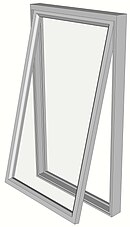Casement window

A casement is a window that is attached to its frame by one or more hinges.[1] Casement windows are hinged at the side. Windows hinged at the top are referred to as awning windows, and ones hinged at the bottom are called hoppers. They are used singly or in pairs within a common frame, in which case they are hinged on the outside. Casement windows are often held open using a casement stay.

In the UK, casement windows were the most common house window before the sash window was introduced,[2] and usually contained leaded glass—glass panes held in place with strips of lead (called lead "cames"; leaded glass is not to be confused with lead glass, which refers to the manufacture of the glass itself).[3] These casement windows usually were hinged on the side, and opened inward. The windows were covered by functional exterior shutters, which opened outward. Variants of casement windows are still the norm in many European countries, such as Denmark and Sweden.
They are opened with a crank, lever, or cam handle, which is placed around hand height or at the bottom and serves as a window lock.[4] A crank, stay, or friction hinge is necessary when the window opens outward, to hold the window in position despite wind.
Often the glass panes are set in a rabbeted frame and sealed with beveled putty or glazing compound to secure the glass.
Casement windows and natural ventilation
Casement windows are also excellent for natural ventilation strategies, especially in hot climates. They can be hinged to open outward and angled in order to direct breezes into the building.
-
Out-swinging shutter, in-swinging window
-
Danish casement window
-
Casement window on Crete
-
Casement window
-
Casement window swinging in
-
Window locks use lever handles
Notes
- ^ Poppeliers, Chamers, Jr.; Schwartz (1983). What Style is it?. NY: John Wiley and Sons. p. 98. ISBN 0-471-14434-7.
{{cite book}}: CS1 maint: multiple names: authors list (link) - ^ The Original Box Sash Windows Company: History of the Sash Window Linked 2015-07-05
- ^ "Casement window". Illustrated Architectural Dictionary. Archived from the original on 2007-12-24. Retrieved 2008-01-18.
{{cite web}}: Unknown parameter|deadurl=ignored (|url-status=suggested) (help) - ^ Ching, Francis (1997). A Visual Dictionary of Architecture. New York: Van Nostrand Reinhold. pp. 113, 116, 273. ISBN 0-442-02462-2.








